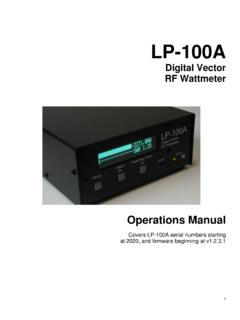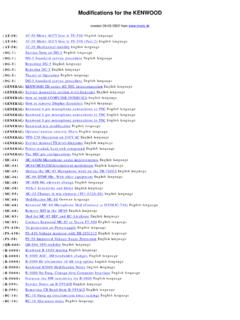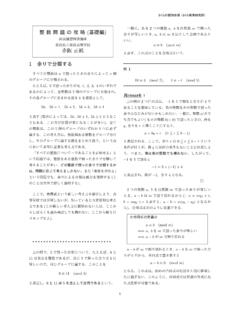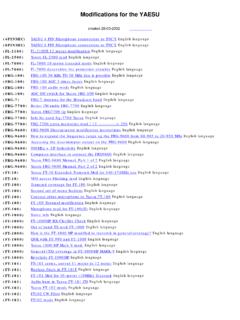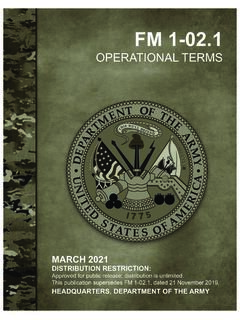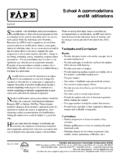Transcription of Doug Hall, K4DSP - Telepost Inc. Home Page
1 doug hall , K4 DSPA pril 27, 2008 This document describes the steps necessary to interface a SoftRock (or similar Quadrature Sampling Detector) to the MHz IF of a Kenwood TS-2000 : This procedure requires you to modify your TS-2000 at the circuit board level. As of this writing I have performed the modification on two different TS-2000 transceivers with absolutely no problems. The modifications are fairly simple (no traces to cut) and are reversible, but I will not be responsible for any damage to your radio as a result of these modifications. A mistake could render your radio inoperable and could result in expensive repairs. If you are not comfortable reading a schematic and working at the circuit board level (or if you just can t take responsibility for your own actions) then don't do these modifications.
2 There are no kits is currently a lot of interest in Software Defined Radio technology, especially with the availability of the inexpensive SoftRock SDR kits. (See for more info.) A simple board using a Quadrature Sampling Detector (QSD) can be used with PC software and a good sound card to create a very capable radio receiver. If such a receiver is coupled to the IF circuitry of an existing general coverage receiver then one gets the best of both worlds - all band coverage with a panoramic view of the frequencies around the currently tuned frequency, and the ability to receive multiple signals simultaneously, ie. most commercial radios do not make the IF signal available externally to the user.
3 In my case I wanted to use my Kenwood TS-2000 HF/VHF/UHF transceiver with a SoftRock board to provide a panoramic display and dual receive capability. The TS-2000 has a quadruple conversion receiver with IF frequencies of 69 MHz, MHz, 455 kHz, and 12 kHz. Examination of the schematic revealed that the best place to tap into the IF chain would be in the MHz IF section. In searching for a tap point I had several requirements:1. Avoid loading the existing IF signal2. Avoid injecting noise or other signals back into the IF chain3. Provide an output that was compatible with a SoftRock module4. Have no impact on regular TS-2000 performanceI achieved these goals by tapping onto the output of Q22, an amplifier on the receiver board which buffers and amplifies the IF signal and feeds it to the noise blanker circuitry.
4 I then built a simple two stage FET buffer amplifier which takes this signal and feeds it to the rear panel of the TS-2000. The FET buffer provides additional isolation and also includes an attenuator which lowers the IF output signal to a level suitable for feeding directly to the Interface to Kenwood TS-2000 MHZ IFAssumptionsThis writeup assumes the following are not using the HF RX antenna jack on the TS-2000. If you are then you'll have to figure out another way to bring out the IF signal from the do not have the DRU-3A digital voice recorder or VS-3 voice synthesis units installed. If you do then you'll have to find another place inside the radio to mount the interface circuit described have a SoftRock (or similar) that operates at or near MHz.
5 MHz works but is not ideal. I'll go into more detail about that first thing you need is a circuit to buffer the MHz IF signal and to provide isolation from the local oscillator (LO) on your SoftRock. The SoftRocks exhibit a fair amount of leakage of their LO out through the antenna port. Since you're going to be hooking the IF output of the Kenwood to the SoftRock's antenna input you want as much reverse isolation as possible. Putting a MHz signal back into the MHz IF circuitry would not be a Good Thing. Figure 1 shows the schematic for a simple FET buffer using a couple of J310 1 - FET Buffer SchematicI experimented with bipolar transistors as well as FETs and got better performance from the FETs.
6 If you are skilled in analog design (it's not one of my strengths) you can probably come up with something smaller/better/simpler. This circuit works for me. I used the J310 FETs because I had a bunch of them on hand. Others would probably work as well or better. I designed a simple PCB that would fit into the area designated SoftRock Interface to Kenwood TS-2000 MHZ IFfor the DRU-3A voice recorder module. I don't have this module and have no plans to buy it, so if you do you'll have to find a different mounting location for your buffer you have built and tested the FET buffer it s time to open up the TS-2000 and mount the board and wire the cables. Here s what you the bottom cover of the W1, a white plastic connector shell that has a shielded cable jumper going into it.
7 This jumper carries the IF signal (amplified by Q22) to the TS-2000 noise blanker circuitry. There are two connectors marked W1 - you want the one shown in the photograph below. (All photos are viewed from the handle side of the radio) a small pair of diagonal cutters or wire snippers carefully (very carefully) cut away the white plastic shell surrounding the wires going into W1. The wires go to pins that are soldered into the PC board. Take your time and don t get over-zealous. You don t want to cut the wires or the pins, and you don t want to damage the PC board. The result will look like this:SoftRock Interface to Kenwood TS-2000 MHZ pins you have exposed by cutting away the shell will be our W1 connection point for the MHz IF signal.
8 The white wire (on the right in the above photo) is the IF signal, and the black wire is ground. Do NOT cut these wires. We re simply going to solder the wires going to the input of the FET buffer to the pins going into the PC board. Use shielded cable (I used miniature coax) to go from the W1 connection point to the input of your FET buffer, and keep the cable you ll need to mount the board. I put a piece of cardboard in the area normally designated for the VS-3 or DRU-3A options (I don t ever plan to get either of these, so the space was perfect for my FET buffer board) and held the cardboard down with double sticky tape. I used the same stuff to attach the FET buffer board to the route the output of the FET buffer board (again, use shielded cable) around the side and back of the radio over to the RCA phono connector used for the HF RX Antenna jack.
9 Note: when the RX antenna is not used (not enabled in the TS-2000 menu) it is also disconnected physically by a relay. So it makes a good place to bring out the IF signal. If you actually use the HF RX antenna jack then you re going to have to find another way to get the signal out of the radio. You might consider the place where the GHz pigtail comes out. I haven t tried that but it should be possible. Route your +12V power and ground wires from the board along the same route as the output cable. In the following photo the input to the FET buffer is on the SoftRock Interface to Kenwood TS-2000 MHZ IFleft side of the board and the output is on the right side of the board. The result should look something like this:SoftRock Interface to Kenwood TS-2000 MHZ solder the output cable to the HF RX Antenna RCA phono jack.
10 The metal exposed at the rear of the connector is the center conductor. You can attach the ground side of your output cable to the PC board screw near the RCA connector. In my case I added the 20 dB attenuator (Resistors R5, R6, and R7) after I did the FET buffer board, so I just soldered them onto the RCA connector. You can save yourself that hassle if you put them on your FET buffer board. The connection to the RCA connector looks like the +12V feed wire for your FET buffer to the top (cathode) of diode D9 as shown in the above photo. I soldered a 220 ohm resistor to the top of the diode and then attached the +12V wire to the other end of the resistor, covering it with heat shrink tubing.

